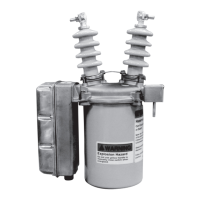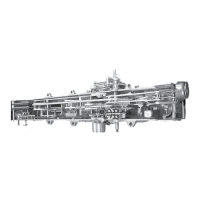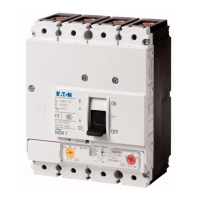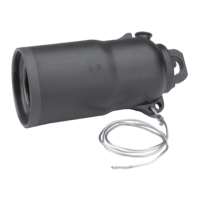Basic control operations
Set voltage
The set voltage is the voltage level to which the control
will regulate on the 120 V or 240 V base. Since the control
performs ratio correction in the firmware, this value will
typically be set for 120.0 V/240.0, unless it is desired to
operate at a voltage level higher or lower than nominal. For
proper operation, the ratio-correcting transformer, located on
the back panel of the control enclosure, must also be set for
the correct tap as shown on the regulator nameplate.
Bandwidth
The bandwidth is defined as that total voltage range, around
the set voltage, which the control will consider as a satisfied
condition. As an example, a 2 V bandwidth on a 120 V set
voltage means the time delay timer will not activate until
the voltage is below 119 V or above 121 V. When the voltage
is in-band, the band edge indicators are off and the timer
(time delay) is off. Selection of a small bandwidth will cause
more tap changes to occur, but will provide a more tightly
regulated line. Conversely, a larger bandwidth results in
fewer tap changes, but at the expense of better regulation.
Selection of the bandwidth and time-delay settings should
be made recognizing the interdependence of these two
parameters.
Time delay
The time delay is the period of time (in seconds) that the
control waits from when the voltage first goes out-of-band
to the time when a tap change is issued. If a rapid response
is required, a shorter setting should be used. If several
devices on the same line are to be coordinated (cascaded),
different time-delay settings will be required to allow the
devices to operate in the desired sequence. Proceeding
from the source, each device should have a longer time
delay than the preceding device. A minimum 15-second
difference between regulators located on the same phase
on the same feeder is recommended. The delay allows
the upstream device to perform its operations prior to the
downstream device reacting. The time-delay setting of a
voltage-minimizing, activated capacitor control should be set
the same as a regulator control. Alternate time delays are
available with the voltage limiter feature. Refer to Section6:
Control Features: Voltage limiter for more information.
Line drop compensation, resistance and reactance
settings
Quite often regulators are installed some distance from the
theoretical load center (the location at which the voltage is
to be regulated). This means the load will not be served at
the desired voltage level due to the losses (voltage drop) on
the line between the regulator and the load. Furthermore,
as the load increases, line losses also increase, causing
the lowest voltage condition to occur during the time of
heaviest loading.
To provide the regulator with the capability to regulate
at a projected load center, the control has line-drop-
compensation elements within it. This circuitry usually
consists of a current transformer (CT), which produces a
current proportional to the load current, and resistive (R) and
reactive (X) elements through which this current flows. As
the load increases, the resulting CT current flowing through
these elements produces voltage drops, which simulate the
voltage drops on the primary line.
Within the control, the input current is sampled and is used
in a computer algorithm which calculates the respective
resistive and reactive voltage drops based upon the line-
drop-compensation values programmed into the control at
FC 4 and FC 5 (or FC 54 and FC 55 for reverse power flow
conditions). This is an accurate and economical means of
developing the compensated voltage.
To select the proper R and X values, the user must know
several factors about the line being regulated.
Regulator configuration
The control is designed to operate on wye (star)-connected
and delta-connected regulators. Regulators connected line-
to-ground (wye) develop potentials and currents suitable for
direct implementation in the control. Regulators connected
line-to-line (delta) develop a potential-to-current phase shift
which is dependent upon whether the regulator is defined
as leading or lagging. The phase shift must be known by the
control to permit accurate calculations for correct operation.
This is accomplished by entering the proper option at FC41:
Wye, Delta Lagging, or Delta Leading. See Section3:
Initial Control Programming: Determination of leading
or lagging in delta-connected regulators for more
information on setting this parameter.
Control operating modes
The CL-7 control supports three modes in which the control
responds to out-of-band conditions, permitting use of the
mode that best fits the application. The three modes are
Sequential, Time Integrating, and Voltage Averaging. The
mode setting can be selected by scrolling within FC 42 or
through Settings > Configuration in the menu structure.
Sequential mode
This is the standard mode of response. When the load
voltage goes out-of-band, the time-delay circuit is activated.
At the end of the time delay, a tap change is initiated.
After each tap change, a 2-second pause occurs to permit
the control to sample the voltage again. This sequence
continues until the voltage is brought into band, at which
time the timing circuit is reset. Whenever the voltage goes
in-band, the timer is reset.
Time-integrating mode
When the load voltage goes out-of-band, the time-delay
circuit is activated. At the end of the time-out, a tap change
is initiated. After each tap change, a 2-second pause occurs
to permit the control to sample the voltage again. If the
voltage is still out-of-band, another tap change is performed.
This sequence continues until the voltage is brought
27
INSTALLATION, OPERATION, AND MAINTENANCE INSTRUCTIONS MN225003EN April 2018
CL-7 Voltage Regulator Control

